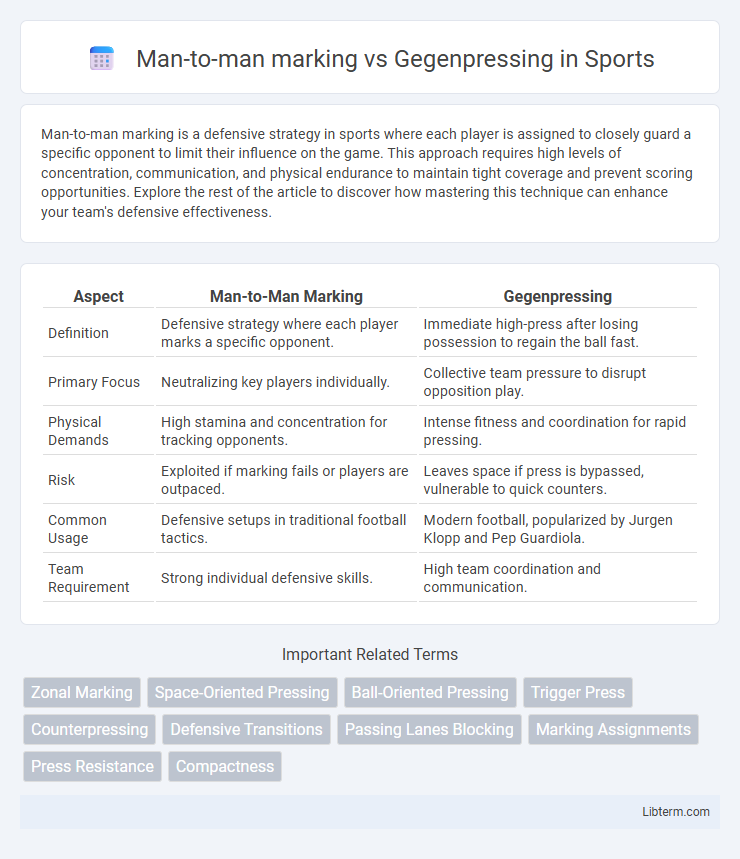Man-to-man marking is a defensive strategy in sports where each player is assigned to closely guard a specific opponent to limit their influence on the game. This approach requires high levels of concentration, communication, and physical endurance to maintain tight coverage and prevent scoring opportunities. Explore the rest of the article to discover how mastering this technique can enhance your team's defensive effectiveness.
Table of Comparison
| Aspect | Man-to-Man Marking | Gegenpressing |
|---|---|---|
| Definition | Defensive strategy where each player marks a specific opponent. | Immediate high-press after losing possession to regain the ball fast. |
| Primary Focus | Neutralizing key players individually. | Collective team pressure to disrupt opposition play. |
| Physical Demands | High stamina and concentration for tracking opponents. | Intense fitness and coordination for rapid pressing. |
| Risk | Exploited if marking fails or players are outpaced. | Leaves space if press is bypassed, vulnerable to quick counters. |
| Common Usage | Defensive setups in traditional football tactics. | Modern football, popularized by Jurgen Klopp and Pep Guardiola. |
| Team Requirement | Strong individual defensive skills. | High team coordination and communication. |
Introduction to Man-to-Man Marking and Gegenpressing
Man-to-man marking involves defenders individually tracking and challenging their assigned opponents to minimize their influence on the game. Gegenpressing, a high-intensity tactical strategy popularized by German teams, emphasizes immediate pressing to regain possession right after losing the ball. Both approaches require disciplined positioning and tactical awareness to disrupt the opponent's play effectively.
Historical Evolution of Defensive Tactics
Man-to-man marking, rooted in early 20th-century football, emphasized individual defensive responsibility, with players closely tracking their opponents to limit space and options. Gegenpressing emerged prominently in the late 20th and early 21st centuries, popularized by German teams like Borussia Dortmund and Bayern Munich, focusing on immediate ball recovery through coordinated team pressure after losing possession. This shift from rigid individual marking to dynamic collective pressing reflects an evolution driven by tactical innovations and increased athleticism, reshaping defensive strategies in modern football.
Core Principles of Man-to-Man Marking
Man-to-man marking centers on assigning each defender to closely track a specific opponent, minimizing space and disrupting their ability to receive or control the ball. This defensive tactic emphasizes anticipation, physicality, and spatial awareness to limit the marked player's influence on the game. Effective man-to-man marking demands constant communication and stamina to maintain pressure throughout the match.
Key Concepts Behind Gegenpressing
Gegenpressing centers on immediate, collective pressure after losing possession, aiming to disrupt the opponent's transition and regain the ball quickly. Man-to-man marking emphasizes individual defensive responsibility, where each player tracks a specific opponent to limit their influence on the game. Contrary to static man-marking, gegenpressing relies on dynamic, coordinated team movements to overwhelm opponents and force errors high up the pitch.
Strengths of Man-to-Man Marking
Man-to-man marking excels in tightly disrupting opponent play by assigning specific players to closely shadow key rivals, limiting their space and reducing passing options. This defensive strategy enhances accountability and helps teams neutralize individual threats through personalized pressure. Its strength lies in forcing opponents into hurried decisions, often leading to turnovers and disrupting rhythmic attacks.
Advantages of Gegenpressing in Modern Football
Gegenpressing offers the tactical advantage of immediately regaining possession by applying intense, coordinated pressure high up the pitch, disrupting the opponent's buildup and minimizing their time on the ball. Unlike man-to-man marking that can isolate defenders, gegenpressing promotes collective team effort, enhances defensive solidity, and accelerates quick transitions into attack. This strategy is particularly effective in modern football where speed, stamina, and synchronization among players drive successful ball recovery and offensive momentum.
Common Vulnerabilities in Both Approaches
Man-to-man marking and Gegenpressing both suffer from spatial vulnerabilities as they require intense individual and collective coordination, often leading to open spaces if a player is bypassed. In man-to-man marking, players are prone to being outpaced or dragged out of position, creating gaps exploited by quick passing or diagonal runs. Gegenpressing relies on immediate ball recovery, but it risks being countered by precise long balls or switch plays that exploit the aggressive pressing triggers.
Tactical Adaptability and Team Dynamics
Man-to-man marking demands intense individual focus and physical endurance, allowing teams to neutralize key opponents through direct pressure and close coverage. Gegenpressing prioritizes rapid collective team responses immediately after losing possession, creating high-pressure zones to regain control and disrupt opposition build-up. Tactical adaptability in shifting between these systems hinges on player roles and communication, with man-to-man emphasizing individual accountability and Gegenpressing relying on synchronized team movements and dynamic spatial awareness.
Case Studies: Successful Implementations
Man-to-man marking has been effectively utilized by Atletico Madrid under Diego Simeone, where players closely track opponents to disrupt passing lanes and limit attacking options. In contrast, gegenpressing, popularized by Jurgen Klopp's Liverpool, emphasizes immediate counter-pressing after losing possession to regain control quickly and create scoring chances. Both tactics showcase strategic adaptations to modern football, with Atletico's disciplined marking and Liverpool's intense pressing yielding significant competitive success in domestic and international competitions.
Choosing the Best Approach: Factors to Consider
Choosing between man-to-man marking and gegenpressing depends on team fitness, tactical discipline, and opponent style. Man-to-man marking requires high individual defensive skills and stamina, ideal against teams with strong key players, while gegenpressing focuses on quick ball recovery and collective pressure, demanding intense physical and mental coordination. Coaches must evaluate player attributes, match context, and the desired defensive intensity to select the most effective strategy.
Man-to-man marking Infographic

 libterm.com
libterm.com